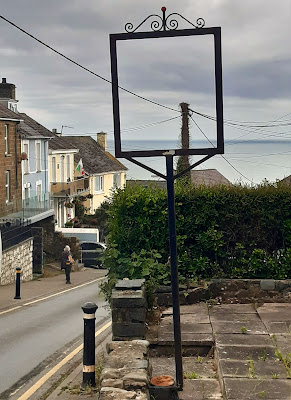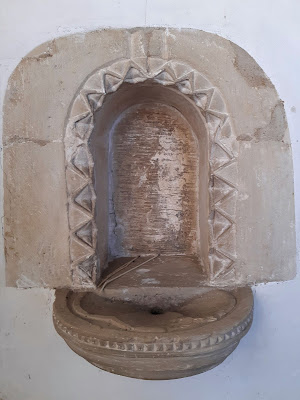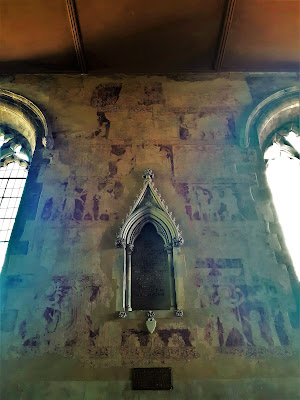By now I was in a bit of a tizz in case the focal point of my trip - another ironstone St Mary's, this time at Bloxham, where I knew there were windows by Morris & Co - was also hosting a wedding. Not to be able to go inside would be awful. I arrived with my heart in my mouth ...
... and there were no pealing bells, no fancy cars adorned with white ribbons, no happy-ever-afters in the offing, so I tried the handle of the first door I came to ... and it was locked.
Then I came across another, splendid door in the South Porch. I pushed it and ...
... it opened. Hallelujah!
I made a beeline for the windows before a sudden tornado could blow them in and dash the goblet of victory from my lips. There was some mediaeval glass ...
... a window by Charles Kempe (which didn't photograph at all well), and these Morris & Co beauties ...
St Christopher (in the chancel)
I was especially taken with the colours and simplicity of the St Christopher window.
Other treasures included ...
... this carved capital, from this angle showing St George depicted as a knight from the time of King Edward I ...
... the painted rood screen, a survival from the 15th century and showing damage inflicted on it during the Reformation, when the original cross disappeared and the vicar, John Wade, was sentenced to be hanged from the church steeple (though apparently survived to write his will a few years later) ...
... the remnant of a Doom mural, above the chancel arch ...
... yet another (fragmentary) St Christopher ...
... and this mural I've seen described as depicting the Life of an Unknown Martyr, but elsewhere, the King and his People.
This spectacular 12th century Norman tympanum over the door to the vestry was probably originally outside ...
... and while it's not to my taste, the monument of Sir John Thorneycroft, who died in 1725, reminded me strongly of that of the Bishop of Bath and Wells, Richard Kidder and his wife, who died during the Great Storm of 1703, when a chimney fell on their bed, and whose daughter can be seen in a similar reclining position in Wells Cathedral - though Sir John's breast and knee clearly don't get groped anywhere near as much as Susanna Everard's do.
If I have a criticism - OK, I do have a criticism - it's that it's a shame, surely, to wedge a 15th century clamp-fronted oak chest behind some pews where it can't be glimpsed, let alone admired; worse still to leave bin bags on top of it.
And wouldn't the Jacobean font cover look better on the font than on the floor?
I expect the powers-that-be of Bloxham have their reasons.
Another quick perambulation outside, where, in the arch of the south porch, I spotted these crusader crosses ...
... and some wonderful carvings around the door I tried to enter through originally, in the tower. Perhaps if I hadn't been so taken with them, I might have noticed the notice instructing visitors to use the other door.
Then on to Great Tew, where I wanted to visit St Michael and All Angels, which also has some mediaeval paintings. (Fortunately I managed to cross the road a little more safely than this toad.)
Another ironstone church, another splendid Norman arch to enter under.
The 15th century seemed to be featuring large on this jaunt. Here is another 15th century font, somewhat less delicate than Bloxham's ...
and this, which I absolutely love, is a 15th century eagle lectern that reminded me of a ship's figurehead.
This knight and his supposed wife, whose effigies date from the 14th century, are now separated by a screen which forms the wall of the vestry. He is believed to be Sir Robert De Vere, but it's all a bit confusing as its date doesn't fit with the Robert de Veres (Earls of Oxford) known to posterity.
The female effigy is of an abbess, thought to be Abbess Margery Dyve of Godstowe, who lived from 1316 to 1355. She is believed to be the widow of Sir Robert de Vere, in which case she would have committed herself to Godstow after his death.
Another knight and his lady are commemorated in this monumental brass, which you have to get at by rolling back a carpet. This is John Wylcotes and his wife, Alice Chelmscote, the brass dating from 1410.
It was the 14th century wall paintings I'd come for, though, vestiges of which you can make out behind the altar. More visible is the panel comprising scenes from the Passion in strip form on the wall of the south aisle. That it has a Victorian memorial slap bang in the middle of it points to the fact that like almost all mediaeval murals, these were whitewashed during our country's cultural revolutions of the 16th and 17th centuries and forgotten about for centuries.
The detail of this mural can be read about here.
I'd planned to finish my ironstone odyssey with a visit to see the paintings at St Bartholomew's Church in Yarnton, but Son the Elder texted to say he'd finished roboteering an hour and a half earlier than planned and needed picking up, and maybe it was as well as it's built of limestone.
It had been a treat of a jaunt, though, with bonus sightings of six red kites, and hopefully there'll be an opportunity to return to Oxfordshire before too long.












































































































